Tay Ninh is not only famous for the majestic Ba Den Mountain or the solemn Cao Dai Holy See, but also hides a captivating green gem – Lo Go Xa Mat National Park. This place is not just a primeval forest with a rich and diverse flora and fauna system, but also a historical witness with valuable revolutionary relics. If you are looking for a destination to immerse yourself in nature, explore new things, and learn about the nation’s heroic history, then Lo Go Xa Mat is the perfect choice. Let’s explore this special national park in detail with “Du lịch khắp thế gian” through the article below.
1. Overview of Lo Go Xa Mat National Park – “Green Gem” of Tay Ninh
Before starting our exploration journey, let’s together learn about the most general information about Lo Go Xa Mat National Park. From geographical location, history of formation to outstanding ecological features, everything will be revealed right here.
1.1. Prime Location of the National Park
Lo Go Xa Mat National Park is located at 235 National Highway 22B, Tan Binh commune, Tan Bien district, Tay Ninh province. With this location, the national park is about 35km from the center of Tay Ninh city and about 135km from Ho Chi Minh City. This geographical location creates favorable conditions for visitors from neighboring provinces and cities to easily travel to visit and explore.
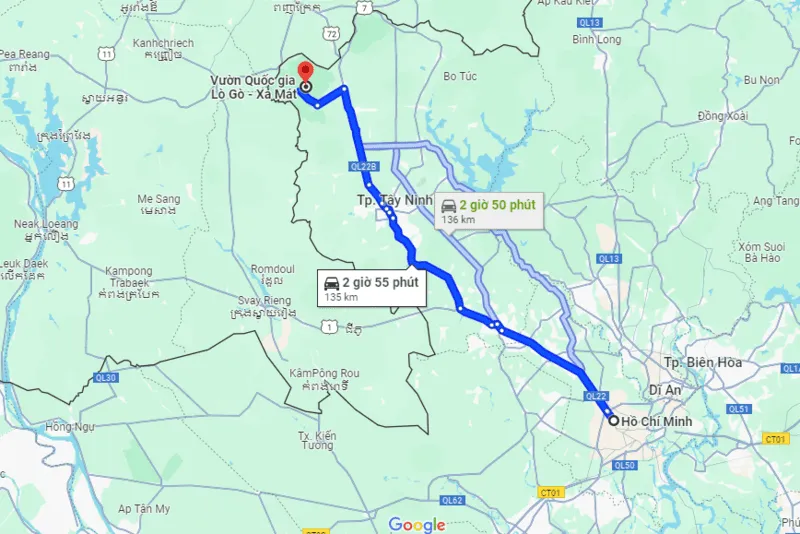
Lo Go Xa Mat National Park has geographical coordinates stretching from 11°00’30” to 11°47’00” North latitude and from 105°57’00” to 106°07’10” East longitude. The park has a special adjacent position when:
- The North and West border with the Vietnam – Cambodia national border, creating a green border area with great tourism potential.
- The South is adjacent to Hoa Hiep, Thanh Tay, Thanh Bac, and Thanh Binh communes of Tan Bien district.
- The East borders with Tan Hoi and Tan Ha communes of Tan Chau district.
1.2. Unique Origin of the Name
The name “Lo Go Xa Mat” probably makes many people curious about its origin. In fact, this name is a harmonious combination of two famous landmarks of Tay Ninh province: Lo Go (Xom Moi) in Hoa Hiep commune, Tan Bien district, and Xa Mat border gate. Xa Mat border gate plays an important role in trade and foreign economic development of the province, while Lo Go is a place imbued with historical and cultural imprints. This combination not only creates a unique, easy-to-remember name but also reflects the location and significance of the National Park.
1.3. History of Formation and Development
Lo Go Xa Mat National Park has gone through a process of formation and development full of imprints, marking the efforts to conserve nature and promote the historical value of this land.
| Timeline | Detailed Information |
|---|---|
| 1986 | The forest area of Lo Go Xa Mat was recorded to be about 10,000 ha according to Decision No. 194/CT. |
| 1996 | The Cultural, Historical and Environmental Forest Area Project was established, marking the beginning of the conservation and ecotourism development process. |
| 1997 | The Special-Use Forest Management Board was officially established, strengthening forest management and protection. |
| 1999 | The area was proposed to be re-evaluated and expanded the conservation area, showing concern for biodiversity values. |
| 2001 | The assessment results showed that the area has high biodiversity value, affirming the importance of conservation. |
| 2002 | Lo Go Xa Mat Nature Reserve was upgraded to a National Park according to Decision No. 91/2002/QD-TTg, marking an important development step. |
| 2019 | Lo Go Xa Mat National Park was honored to be recognized as an ASEAN Heritage Park, affirming its international value and position. |
| 2020 | Lo Go Xa Mat National Park was officially established according to Decision No. 1098/QD-UBND, completing the organizational and management structure. |
1.4. Large Area and Functional Zoning
With a total area of up to 30,022 ha (updated December 22, 2023), Lo Go Xa Mat National Park is divided into 3 main zones, each zone undertaking a separate function, contributing to conservation and sustainable development:
- Strict protection zone (10,615.16 ha): This is the “heart” of the national park, where priority is given to preserving the integrity of the natural ecosystem, strictly protecting rare and precious flora and fauna. All resource exploitation and large-scale construction activities are prohibited in this area.
- Ecological restoration zone (30,023 ha): This area plays an important role in regenerating and restoring degraded ecosystems. Here, people are encouraged to participate in nurturing, afforestation, natural forest restoration, water and environmental protection activities.
- Administrative service zone (130.46 ha): This zone is planned to serve management, administrative, and tourism activities. Visitors can find operating offices, guesthouses, amusement parks, tourist routes, and other service facilities. The goal is to create favorable conditions for visitors to visit, rest, and relax, while minimizing negative impacts on the natural environment.
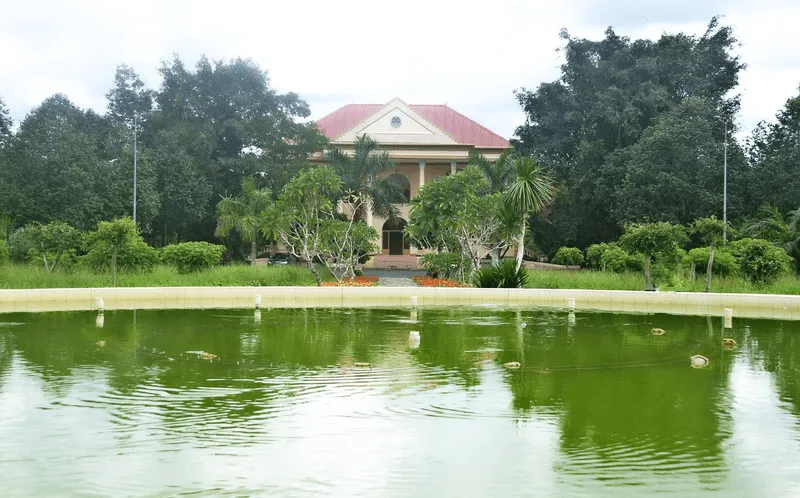
1.5. Diverse and Precious Flora and Fauna Ecosystem
Lo Go Xa Mat National Park is proud to be a place to preserve an extremely rich and diverse flora and fauna ecosystem. With its special geographical location and tropical monsoon climate, this place becomes an ideal habitat for thousands of plant and animal species, many of which are rare and listed in the Vietnam and world Red Books.
1.5.1. Rich and Precious Animal World
The fauna of Lo Go Xa Mat National Park is extremely diverse, including many species of birds, mammals, reptiles, amphibians, and insects. In particular, the national park is a habitat and migratory stop for many rare and endangered bird species.
| Animal Name | Description Information | Illustrative Image (Source: Internet) |
|---|---|---|
| Sarus Crane (grus antigone) | The Sarus Crane is one of the rarest birds in Vietnam and the world. They are characterized by a bare bright red head, and light gray plumage. Sarus Cranes often appear at Lo Go Xa Mat in the dry season, from March to April every year. |  Sarus Crane Sarus Crane |
| Asian Openbill (anastomus oscitans) | The Asian Openbill is a bird of the stork family, easily recognizable with its pure white plumage, glossy black wings with iridescent green or purple. They usually appear from June to October in the flooded grasslands in the national park. | 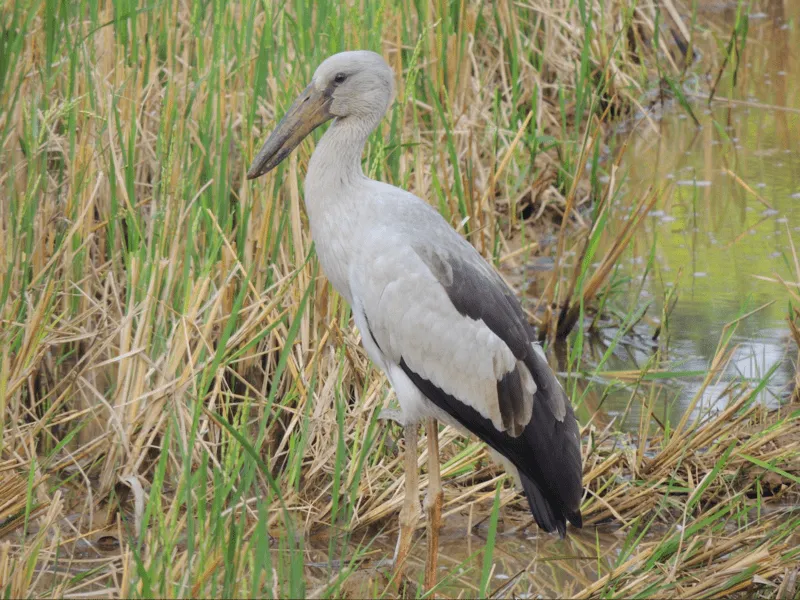 Asian Openbill Asian Openbill |
| Black-shanked Douc (pygathrix nigripes) | The Black-shanked Douc is a rare primate, endemic to Vietnam. They have distinctive gray fur, white buttocks, and a beard-like ruff. Black-shanked Doucs live year-round on tall trees in the Lo Go Xa Mat forest. | 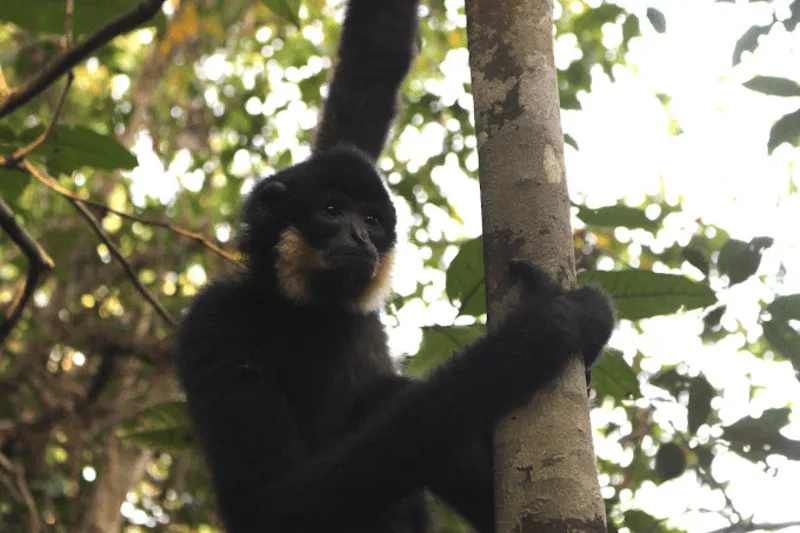 Black-shanked Douc Black-shanked Douc |
| Siamese Fireback (lophura diardi) | The Siamese Fireback is a bird typical of Southeast Asia. They have red legs and facial skin, with males and females having different colors. Siamese Firebacks usually live in dipterocarp forests in Lo Go Xa Mat. |
1.5.2. Diversity of the Plant World
Not only animals, the flora in Lo Go Xa Mat National Park is also extremely rich and unique. This vast forest is home to nearly 1000 different plant species, many of which are rare and endemic, and some species have not yet been fully discovered and studied by scientists.
| Plant Name | Description Information | Illustrative Image (Source: Internet) |
|---|---|---|
| Siam Tulip (curcuma alismatifolia) | Siam Tulip is a herbaceous plant of the ginger family, with beautiful purple-pink flowers. This plant species is often found in Indochina, including Vietnam. |  Siam Tulip (curcuma alismatifolia) Siam Tulip (curcuma alismatifolia) |
| Dendrobium minusculum Orchid | Dendrobium minusculum orchid is a new orchid species of the world, first discovered in Lo Go Xa Mat National Park in 2008 and officially announced in 2009. | 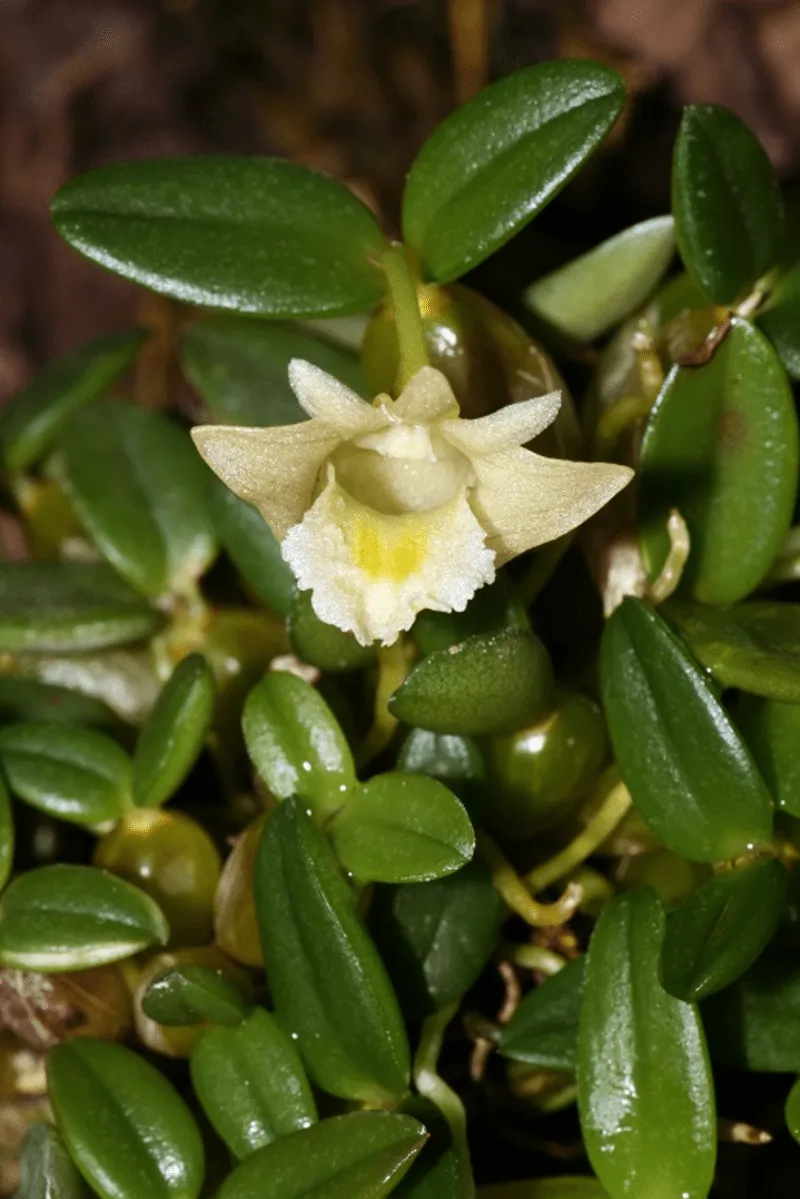 Dendrobium minusculum Orchid Dendrobium minusculum Orchid |
| Thorell’s Pitcher Plant (nepenthes thorelii) | Thorell’s Pitcher Plant is a unique carnivorous plant, once thought to be extinct in the wild for over 100 years. However, this plant species was rediscovered in Lo Go Xa Mat National Park in 2012, bringing great joy to scientists and nature lovers. | 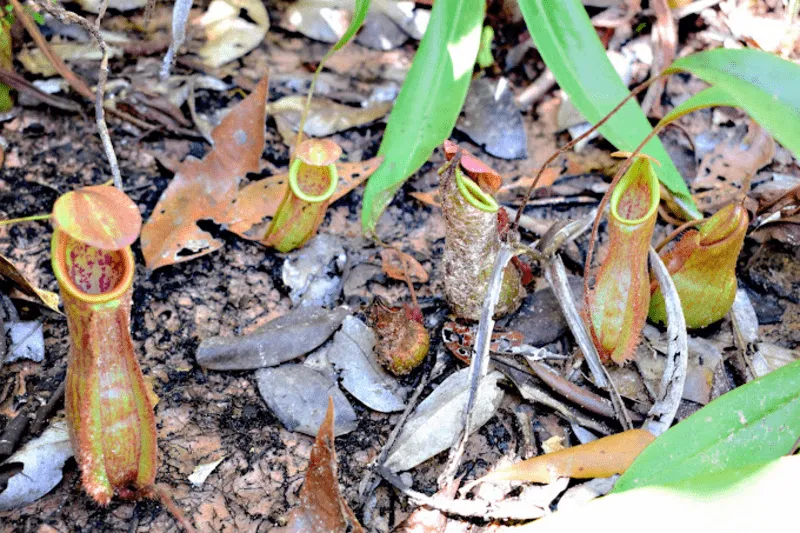 Thorell's Pitcher Plant (nepenthes thorelii) Thorell's Pitcher Plant (nepenthes thorelii) |
| Colona (colona auriculata) | Colona is a plant of the mallow family, with alternate leaves, yellow flowers, and round fruits containing many seeds. Colona often grows in wastelands, and its roots are used in traditional medicine to reduce fever. | 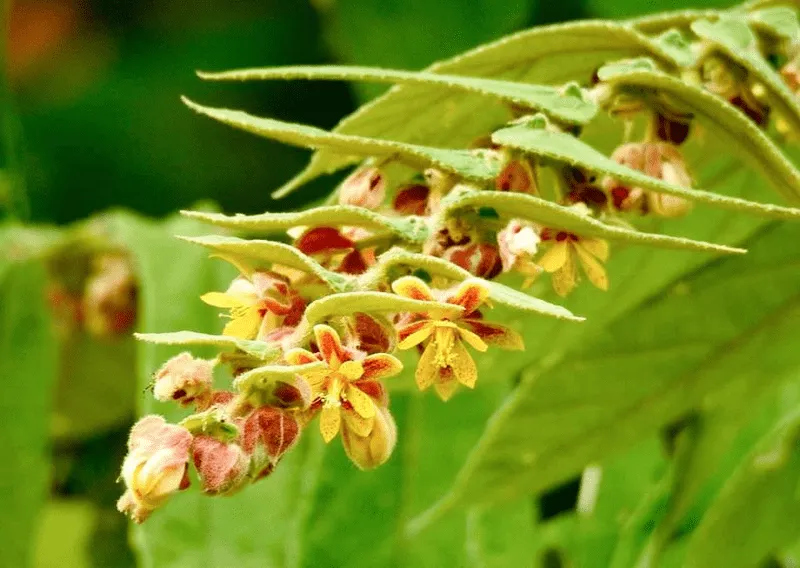 Colona (colona auriculata) Colona (colona auriculata) |
1.6. Ecotourism Planning Map
To help visitors easily visualize and plan their exploration of Lo Go Xa Mat National Park, the ecotourism planning map below will be a useful tool.

2. Top 9 Must-Visit Destinations in Lo Go Xa Mat National Park
Coming to Lo Go Xa Mat National Park, visitors will have the opportunity to explore not only the wild, majestic natural beauty but also admire historical and cultural relics imbued with the imprint of time. Below are the 9 most attractive destinations that you should not miss when coming to the “green gem” of Tay Ninh.
2.1. 32m High Observatory – Panoramic View of the Primeval Forest
The 32m high observatory is one of the special highlights of Lo Go Xa Mat National Park. Built with 8 floors and located in Ta Not grassland, this observatory offers visitors a beautiful panoramic view. Climbing the spiral steps, you will be able to see the entire Lo Go Xa Mat forest with its vast green color stretching to the horizon. Here, you can enjoy the fresh air, listen to the melodious sounds of the forest, the chirping of birds, and feel the gentle fragrance of plants and flowers.
Entrance fee: Free.
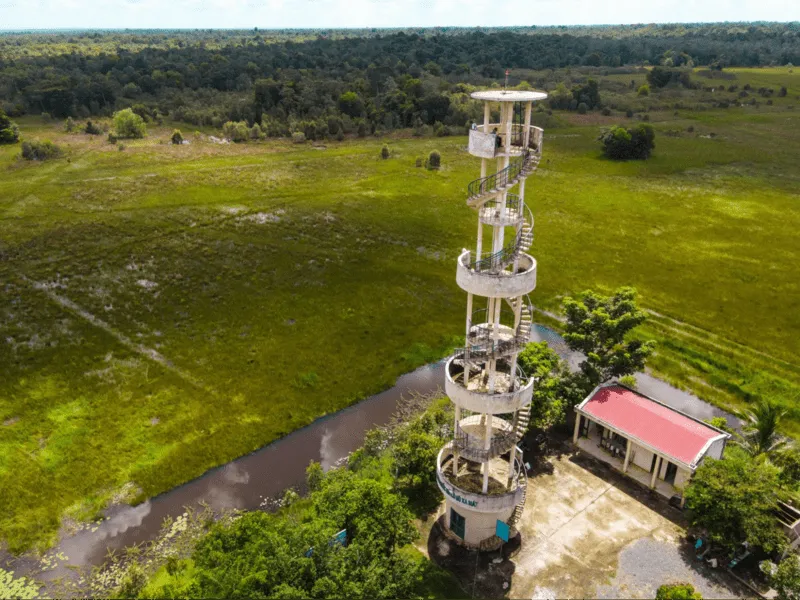
2.2. Upper Vam Co Dong River – Natural Border with Cambodia
Lo Go Xa Mat National Park is where the Vam Co Dong River originates and flows through more than 20km, forming a natural border between Vietnam and Cambodia. Coming to the upper reaches of the Vam Co Dong River, visitors will admire the wild, poetic beauty of the river, which has witnessed many historical ups and downs and cultural exchanges between the two countries.
You can rent a boat or canoe to cruise on the river, admire the green primeval forests, the towering palmyra palm trees, the giant fishing gears of fishermen, and the clumps of water mimosa blooming with bright yellow flowers on the water surface.
Canoe rental fee: VND 1,100,000/trip (maximum 24 people/trip).
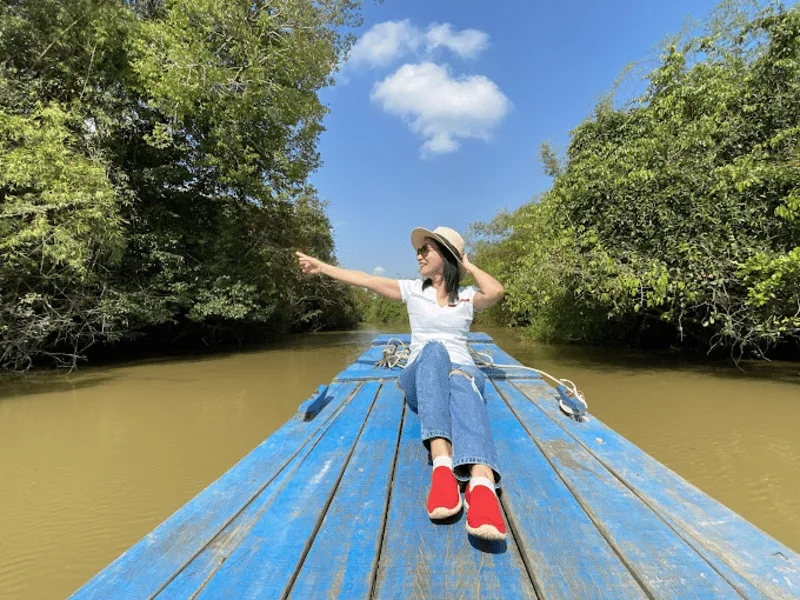
2.3. Landmark 132 (2) – Symbol of Border Peace
Landmark 132 is a double landmark, in which landmark 132 (1) belongs to Cambodia and landmark 132 (2) belongs to Vietnam, guarded by Vietnamese border guards. Landmark 132 (2) is not just an ordinary border landmark but also a symbol of peace and friendship between the two nations.
Visitors can visit landmark 132 (2), perform a solemn flag salute to commemorate the merits of previous generations who sacrificed for the independence, freedom, and peace of the nation. This is also a meaningful check-in location, preserving the moment of setting foot on the sacred sovereignty border of the Fatherland.
Entrance fee: Free.
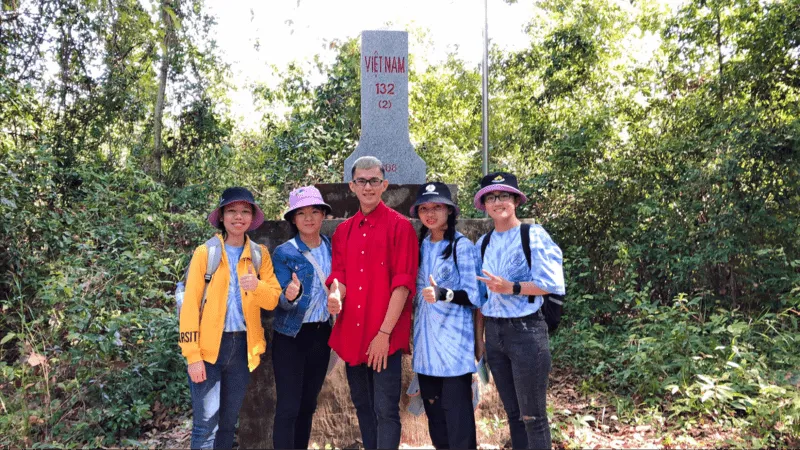
2.4. Ta Not Grassland – Endless Beauty of Wild Grasses
Ta Not Grassland is one of the largest and most beautiful grasslands in Lo Go Xa Mat National Park. Due to its low terrain, Ta Not grassland is often seasonally flooded, creating conditions for many species of wild grasses to grow and develop. This place is an ideal habitat for sedges, cajeput trees, and many other plant species.
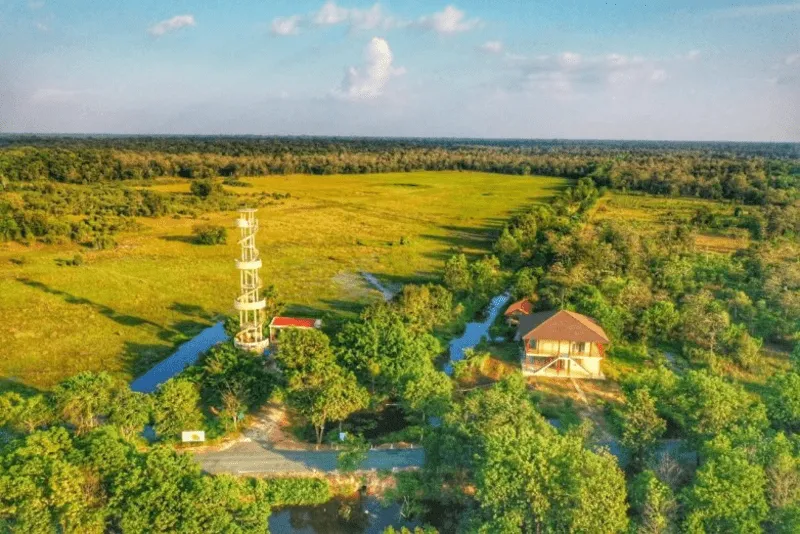
Coming to Ta Not grassland in the dry season (December – April), visitors will admire a golden color covering the entire sky, see the spiny sedge tubers hiding under the dry soil, and have the opportunity to observe rare Sarus Cranes foraging. In the rainy season (May – November), Ta Not grassland puts on a fresh green color, welcoming flocks of Asian Openbills flying in from Cambodia and the Mekong Delta, creating a vibrant and lively natural scene.
Entrance fee: Free.
2.5. 215-Year-Old Hopea Odorata Heritage Tree – Historical Witness of the Forest
The 215-year-old Hopea Odorata ancient tree is one of the “treasures” of Lo Go Xa Mat National Park. In 2016, this Hopea Odorata tree was recognized as a Vietnam Heritage Tree by the Vietnam Association for Conservation of Nature and Environment. With a lifespan of more than two centuries, the Hopea Odorata tree stands tall in the green forest like a historical witness, carrying within it stories and imprints of time.


Coming to admire the Hopea Odorata heritage tree, visitors will be overwhelmed by its massive size – 44 meters high, 2 meters in diameter. Embracing the rough trunk, you will feel the eternity and vitality of nature.
Entrance fee: Free.
2.6. 269-Year-Old Dipterocarpus Alatus Heritage Tree – “Giant” of the Green Forest
Along with the Hopea Odorata tree, the 269-year-old Dipterocarpus Alatus tree is also a Vietnam Heritage Tree in Lo Go Xa Mat National Park. This Dipterocarpus Alatus tree not only has a long lifespan but also has an impressive size – 42 meters high, 2.2 meters in diameter. This Dipterocarpus Alatus species is also known for its resin and bark having many uses in medicine.
Entrance fee: Free.

Standing under the canopy of the ancient Dipterocarpus Alatus tree, visitors will feel their smallness before the vast nature and the greatness of time.
2.7. Memorial House of the Central Propaganda and Training Department of the Southern Department – Revolutionary Historical Relic
The memorial house of the Central Propaganda and Training Department of the Southern Department is an important revolutionary historical relic located in Lo Go Xa Mat National Park. The Central Propaganda and Training Department of the Southern Department played a “spearhead” role in ideological, political, and propaganda work, making an important contribution to the victory of the resistance war against the US for national salvation.
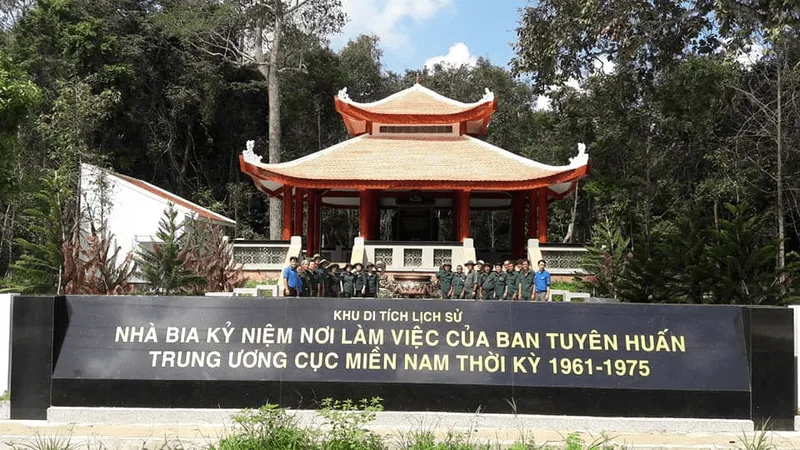
The memorial house was spaciously built in 2020, on the occasion of the 90th anniversary of the traditional day of the Party’s propaganda sector. Coming here, visitors can offer incense and flowers to express their sincerity and gratitude to those who made great contributions to the revolutionary cause of national liberation.
Entrance fee: Free.
2.8. Monument of Nguyen Van Troi School – Imprint of Revolutionary Education
The monument of Nguyen Van Troi School is a special historical educational relic in Lo Go Xa Mat National Park. Nguyen Van Troi School was established in 1965, as a place to nurture and train children of revolutionary cadres and soldiers in the Southeast region. The school existed until 1976 and trained many talents for the country.
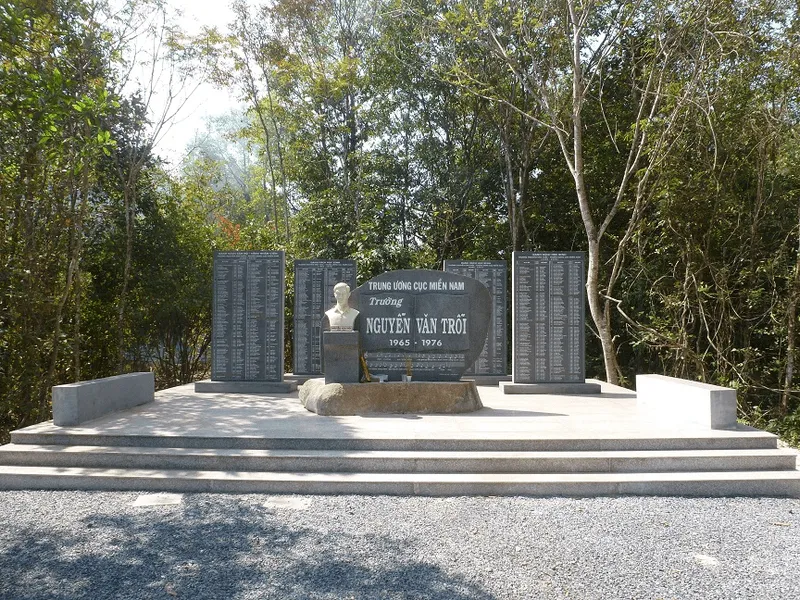
The monument of Nguyen Van Troi School was inaugurated in 2014, marking a special school, a place that shows the noble revolutionary teacher-student relationship and the spirit of studious overcoming difficulties.
Entrance fee: Free.
2.9. Wildlife Rescue and Care Center – Meet Wild Friends
The wildlife rescue and care center is an interesting and meaningful destination in Lo Go Xa Mat National Park. The center is a place to receive, care for, and rehabilitate wild animals that are injured, illegally hunted, or confiscated from wildlife trafficking cases.
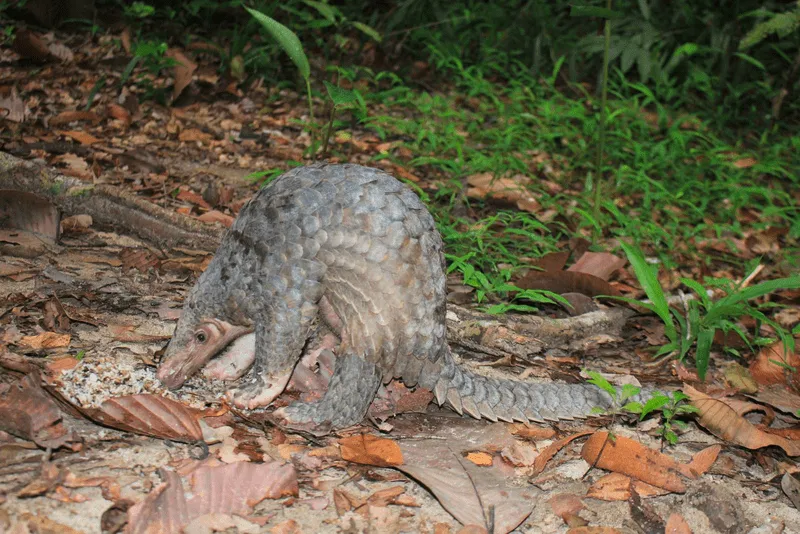
Visiting the center, visitors will have the opportunity to observe up close wild animals such as jungle cats, reticulated pythons, Javan slow lorises, otters, peacocks… and learn about wildlife conservation work. The center also cooperates with other national parks to implement breeding programs and conserve precious gene sources.
Entrance fee: Free.
3. 7 Unique Experiences Not to Miss at Lo Go Xa Mat
In addition to attractive destinations, Lo Go Xa Mat National Park also offers visitors many unique and interesting tourism experiences. From trekking through the forest, cycling to explore nature to enjoying local cuisine and overnight camping, everything will create a memorable exploration journey.
3.1. Trekking Through the Forest – Conquering Wild Nature
Trekking is one of the most popular activities in Lo Go Xa Mat National Park. With relatively flat terrain, few steep slopes and deep ravines, the national park is very suitable for trekking activities, even for beginners. You can join a 24km forest trekking route under the guidance of the National Park Management Board.

On the trekking journey, you will immerse yourself in the green space of the primeval forest, admire the tall ancient trees, cross small murmuring streams, admire wild ginger flowers, wild ginseng flowers showing off their colors, and stop at poetic grasslands to rest and relax.
Fee: Free (need to present personal identification documents upon request).
3.2. Cycling Excursion – Enjoying the Scenery of the Green Forest
If trekking offers a slow exploration experience, cycling excursion is a great way to feel the nature of Lo Go Xa Mat in a dynamic and interesting way. Along the trekking route, you can ride a mountain bike weaving through rugged, winding forest roads, crossing fields of fragrant wildflowers, enjoying the cool breeze and fresh air of the green forest.
Fee: Free (should register the cycling route with the Management Board to ensure safety).
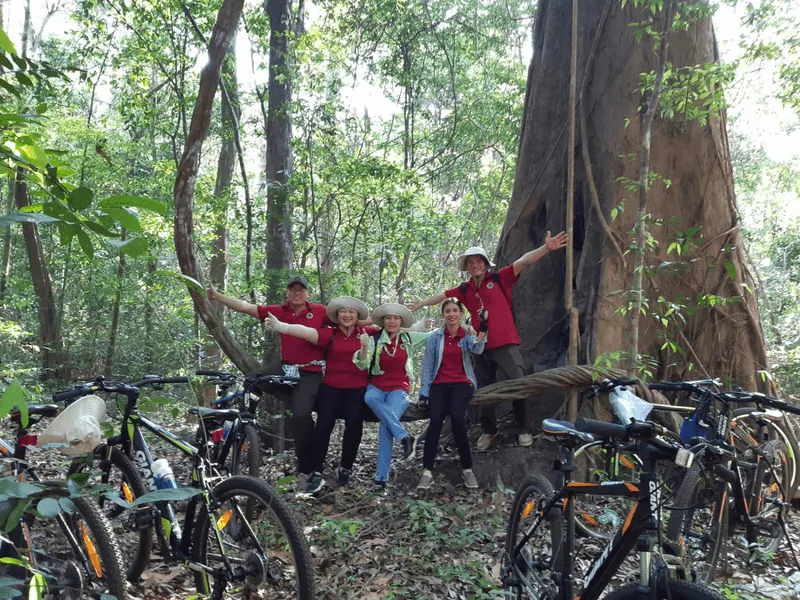
3.3. Listening to the Story of “Forest Keepers” – Understanding Conservation Work
If you have the opportunity to visit Lo Go Xa Mat National Park with forest rangers or the Management Board, do not miss the opportunity to listen to interesting stories from “forest keepers”. You will hear about the difficulties and hardships in forest protection work, from patrolling, preventing illegal loggers to preventing forest fires in the dry season. These stories will help you better understand the value of the forest and the merits of those who are protecting the country’s “green lungs” day and night.
Fee: Free.

3.4. Enjoying Typical Cuisine – Hometown Flavors in the Green Forest
Tay Ninh cuisine always brings visitors unforgettable experiences with bold, rustic flavors. At Lo Go Xa Mat National Park, you will have the opportunity to enjoy typical local dishes such as wild vegetable pancakes, grilled snakehead fish wrapped in rice paper, grilled free-range chicken with salt and chili, stir-fried wild boar with lemongrass and chili… The dishes are prepared from fresh ingredients, imbued with hometown flavors, helping you recharge after hours of exploring the green forest.

3.5. Resting on a Hammock in the Forest – Experiencing the Wild Feeling
Instead of choosing to rest in a room or tent, you can try the experience of sleeping in a hammock in the forest at Lo Go Xa Mat National Park. Hammocks are familiar items of soldiers during the resistance war, bearing a strong historical imprint. Lying back on a hammock swaying under the forest canopy, you will feel peace, relaxation, and completely immerse yourself in nature.
Fee: Free (should prepare insect repellent).

3.6. Day Picnic – Outdoor Picnic in Beautiful Nature
Lo Go Xa Mat National Park is an ideal place to organize day picnics. You can choose areas near ponds and streams in the forest or dry grasslands to set up tents, spread mats, and enjoy lunch amidst beautiful nature. If you go with local people, you can learn more about edible wild vegetables and forest survival skills.
Fee: Free.
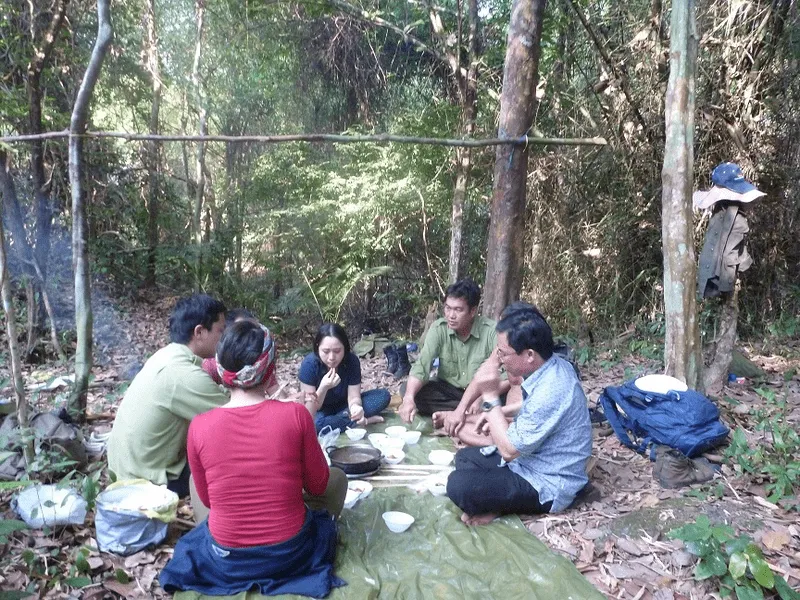
3.7. Overnight Camping – Challenging Yourself and Exploring the Night Forest
If you are a fan of exploration and want to challenge yourself, experience overnight camping at Lo Go Xa Mat National Park. Overnight camping in the forest will bring you completely different experiences, from learning how to make a fire, finding water sources, setting up tents to exploring the mysterious beauty of the night forest. The National Park Management Board has designated camping areas that are strictly controlled, ensuring safety for visitors.
Fee: Free.
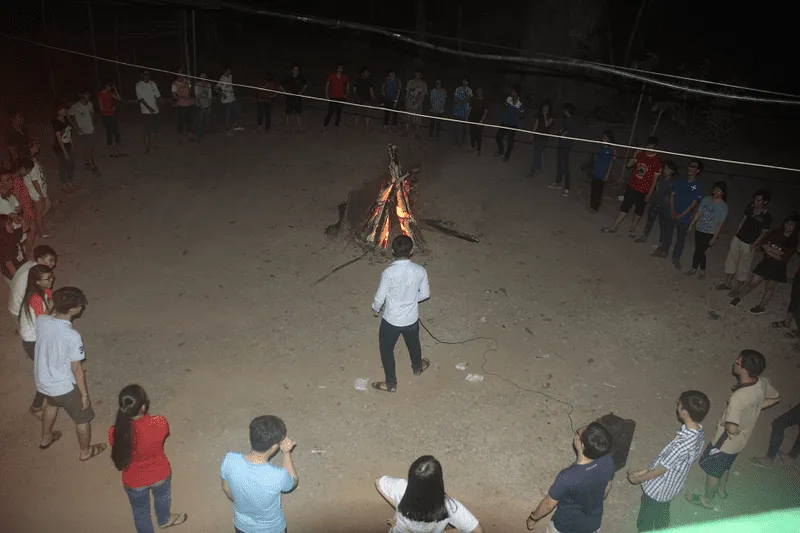
4. Directions to Lo Go Xa Mat National Park
Traveling to Lo Go Xa Mat National Park is quite convenient, you can choose many different means of transport depending on your starting point and personal preferences.
4.1. From Ho Chi Minh City
| Means of Transport | Bus Route/Bus Operator/Road Route | Note |
|---|---|---|
| Motorbike/Self-driving car | – Route: QL22 -> QL22B -> TL783 -> Ta Xia Tan Phu. – Distance: 135 km. – Time: About 3 hours. | Can combine visiting other tourist attractions along the way such as Tay Ninh Holy See, Dau Tieng Lake, Ba Den Mountain. |
| Coach | Dong Phuoc bus operator (An Suong Bus Station – Tan Lap, Tan Bien route). | Request the bus operator to transfer to Lo Go Xa Mat National Park. Should contact in advance to book tickets and confirm information. |
| Bus | Route 701 (Cu Chi Bus Station – Tay Ninh Bus Station) -> Route 7 (Tay Ninh Bus Station – Xa Mat Border Gate). | Get off the bus at the station closest to the National Park and take a taxi or motorbike taxi. |
4.2. From Binh Duong
| Means of Transport | Bus Route/Bus Operator/Road Route | Note |
|---|---|---|
| Motorbike/Self-driving car | Route: TL750 -> TL790 -> TL789 -> TL781 -> TL785 -> TL795 -> QL22B -> TL783 -> Ta Xia Tan Phu. – Distance: 95km. – Time: About 2 hours. | The route is quite complicated, need to pay attention to follow maps and signs. |
| Coach/Bus | Information is being updated. |
4.3. From Tay Ninh City
| Means of Transport | Bus Route/Bus Operator/Road Route | Note |
|---|---|---|
| Motorbike/Self-driving car | Route: QL22B -> TL783 -> Ta Xia Tan Phu. – Distance: 35km. – Time: About 45 minutes. | Short and easy route. |
| Coach/Bus | Route 7 (Tay Ninh Bus Station – Xa Mat Border Gate). | Get off the bus at the station closest to the National Park and take a taxi or motorbike taxi. |
5. Useful Experiences When Visiting Lo Go Xa Mat National Park
To have a complete and meaningful exploration trip to Lo Go Xa Mat National Park, keep the following useful experiences in mind:
5.1. Choosing the Ideal Time to Visit
Each season, Lo Go Xa Mat National Park has its own beauty and attraction. Depending on your preferences and purpose of travel, you can choose the appropriate time:
- Dry season (November – April): Dry, cool weather, suitable for outdoor activities such as trekking, cycling, camping, picnicking. This is also an ideal time to observe rare bird species such as Sarus Cranes, Siamese Firebacks, Javan slow lorises… and admire wild flowers blooming.
- Rainy season (May – October): Green forests, flowers blooming, fresh air. The rainy season is suitable for boating to visit flooded grasslands and watch migrating Asian Openbills. However, it is necessary to prepare appropriate clothing and items to cope with rain and insects.

5.2. Contact the Management Board for Best Support
If you want to participate in specialized tourist routes such as trekking, cycling through the forest, bird watching, flower viewing, or boating on the Vam Co Dong River, please contact the Management Board of Lo Go Xa Mat National Park in advance via hotline 02763 874 018 for the best advice and support on schedules, costs, and necessary procedures.
5.3. Protect the Environment and Comply with Regulations
Lo Go Xa Mat National Park is a strictly protected area, so please join hands to protect the environment and comply with the regulations of the national park. Do not break branches, pick flowers, do not feed animals, do not litter indiscriminately, and do not make loud noises that affect the natural environment and wild animals.
Lo Go Xa Mat National Park is not only an attractive ecotourism destination but also a “living museum” of nature and history. Come and discover this “green gem” of Tay Ninh to enjoy memorable and meaningful experiences!